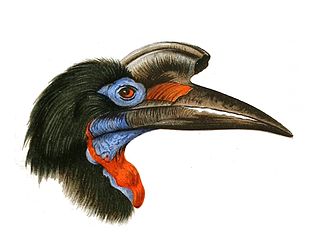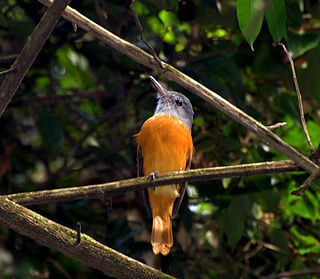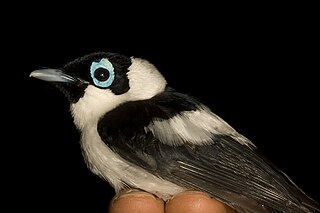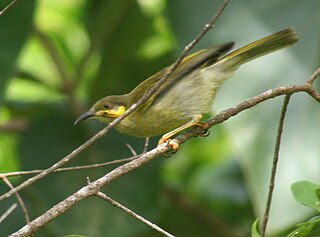
The great stone-curlew or great thick-knee is a large wader which is a resident breeder in tropical southern Asia from India, Pakistan, Sri Lanka, Bangladesh into South-east Asia.

The great black hawk is a bird of prey in the family Accipitridae, which also includes the eagles, hawks, and Old World vultures.

The guira cuckoo, known in Spanish as the pirincho is a species of gregarious bird found widely in open and semi-open habitats of northeastern, eastern and southern Brazil, Uruguay, Paraguay, Bolivia, and northeastern Argentina. It is the only species placed in the genus Guira.

The ground hornbills (Bucorvidae) are a family of the order Bucerotiformes, with a single genus Bucorvus and two extant species. The family is endemic to sub-Saharan Africa: the Abyssinian ground hornbill occurs in a belt from Senegal east to Ethiopia, and the southern ground hornbill occurs in southern and East Africa.

The New Holland honeyeater is a honeyeater species found throughout southern Australia. It was among the first birds to be scientifically described in Australia, and was initially named Certhia novaehollandiae.

The white-cheeked honeyeater is a species of honeyeater that inhabits the east coast and the south-west corner of Australia. It has a large white patch on its cheek, brown eyes, and a yellow panel on its wing.

The Kerguelen petrel is a small slate-grey seabird in the family Procellariidae. It is the only species placed in the genus Aphrodroma. It is a pelagic, circumpolar seabird of the Southern Ocean. It breeds on islands in the southern Atlantic and Indian Oceans.

Attila is a genus of tropical passerine birds, the attilas. They belong to the tyrant flycatcher family. The species in this genus have large heads and hooked bills; they are markedly predatory and aggressive for their size – hence the scientific and common names, which refer to Attila the Hun.

Embernagra is a genus of South American finch-like birds in the tanager family Thraupidae.

Amazilia is a hummingbird genus in the subfamily Trochilinae. It is found in tropical Central and South America.

The festive amazon, also known as the festive parrot, is a species of parrot in the family Psittacidae. It is found in Brazil, Colombia, Ecuador, Bolivia, Guyana, Peru, and Venezuela. It is associated with forest and woodland growing near major rivers. Locally, it is also found in coastal mangroves. There are two subspecies; A. f. festiva and A. f. bodini.

Ketupa is a genus of owls in the family Strigidae. The genus formerly contained just three species, the fish owls but based on the results from a genetic study published in 2020, the generic boundaries were altered. The genus now contains twelve species, nine of which were formerly placed in the genus Bubo.

The violet-backed starling, also known as the plum-coloured starling or amethyst starling, or Ndambamukula in the Luvenḓa (Venḓa) language, is a relatively small species (17 cm) of starling in the family Sturnidae. It is the only member of the genus Cinnyricinclus. This strongly sexually dimorphic species is found widely in the woodlands and savannah forest edges of mainland sub-Saharan Africa. It is rarely seen on the ground, but instead found in trees and other locations away from the ground.

The hook-billed kingfisher is a species of kingfisher in the subfamily Halcyoninae that is resident in the lowland forested areas of New Guinea and some of the nearby islands. It is the only member of the genus Melidora.

The white-fronted honeyeater is a medium-sized bird species endemic to Australia. Mainly distributed throughout arid and semi-arid landscapes. The white-fronted honeyeater has distinct colourings with a white face, black or brown upper chest with white speckles and yellow panels on their brown wings.

Todirostrum is a genus of Neotropical birds in the New World flycatcher family Tyrannidae.

Arses is a genus of monarch flycatchers in the family Monarchidae. The genus is restricted to forest and second growth on the island of New Guinea, a few surrounding islands and northern Queensland, Australia. The genus is separated by their frilled necks, fleshy blue eye wattles and delicate pendent nests. They also have a distinctive foraging technique, hopping up tree trunks in a spiral fashion.

Gracupica is a genus of Asian birds in the family Sturnidae. It is sometimes merged with Sturnus or Sturnia.

Pitohui is a genus of birds endemic to New Guinea. The birds formerly lumped together as pitohuis were found by a 2008 study that examined their evolutionary history on the basis of the genetic sequences to have included birds that were quite unrelated to each other. They have since been separated into other genera.

The wattled honeyeaters form a genus, Foulehaio, of birds in the honeyeater family Meliphagidae.
























